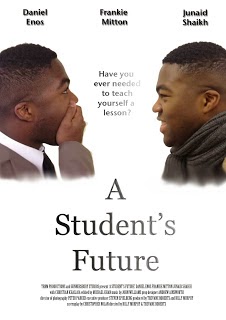Audience feedback is the key aspect which can judge whether a film can be potentially successful or be a potential disaster. The audience are the reason why the media product is able to create revenue and lead to potential profits for without them, there would be no way for the company to create money. By asking audiences to watch the film and then comment on it or individual areas, you will be able to get an answer on what they think could be changed or altered such as the case of the score of a section of a film or a particular ending of the film which the audiences respond negatively to.
For short films, unlike mainstream films which have a wider audience which will therefore appeal to a large variety of people, short independent films will have a certain defined audience. For example, the film 'Fish Tank' whilst not being a short film it is an independent film. It's main target audience are those who enjoy watching social realist films and those who like possible unresolved endings; a common feature in short films. This clearly sets the audience different to that of the mainstream audience who would prefer something more action orientated such as 'Iron Man' which has a clear ending.
Conducting our own research for short films, due to the audience being specifically set for those in education therefore, limiting the number of people who might want to see the film unlike those of a mainstream film. As we have audience feedback for the short film which was done online, and in person we could clearly see that the reason people wanted to see it was because they were in similar situations in terms of exams. By asking the correct appropriate age range we were able to get the responses that we needed. Whereas, if we were to ask the wrong audience such as children or elderly adults they might not have an interest in the film. Therefore, there is a clear difference between the differing audiences which we have been able to find. Through the synergy that media companies have, with our short film and the film poster we have also added this link with each other where the poster could not be produced if there was no synergy between the short film and poster.
By researching the audience profile for mainstream films on the http://business.pearlanddean.com/audience_profile we were able to see that as time has changed so has the differing styles of audience. This is relevant to our groups short film where without the research we might have targeted our film at the wrong type of audience. The sole reason why we decided to go for our film taking an educational role aimed at 15-24 year olds is because the website proves that they are the biggest market for going to the cinema compared to the audience range of 25-34 where they are only 19% of the audience who go to the cinema. Also in terms of demographic audiences again due to the research and the results showing that the large majority of audiences that go to the cinema are ABC1 which spans from upper middle class all the way to lower middle class. Although our film could have been targeted at C2 and D audiences we decided against this as they are not our key focus and we believed that the audiences we have chosen fit more into the educational moral story we have told. Linking to short films it could be said that unlike Hollywood films our demographic profile is actually C1 as those audiences might be able to relate closer to this whilst those higher up might potentially be focused on their work.
As stated previously, audience feedback is the key importance which can potentially influence a films production.
Original Ending
Theatrical Ending
Bane's Voice before and after the editing.
 All this clearly shows just how important audience feedback truly is where without it, such as the case of “Charlie’s Angels: Full Throttle” which was reviewed terribly because of no audience feedback. the film will not perform as well. This caused the actresses that were in that film to be nominated for worst performances and the golden raspberry awards.
All this clearly shows just how important audience feedback truly is where without it, such as the case of “Charlie’s Angels: Full Throttle” which was reviewed terribly because of no audience feedback. the film will not perform as well. This caused the actresses that were in that film to be nominated for worst performances and the golden raspberry awards. When creating our media product we used audience feedback in conjunction with the creation of the media product in order to find out how the audience would respond to each of our areas of our products (film, poster and magazine). We used Facebook, YouTube, group and individual screenings and questionnaires about the media product in order to get the answers . We felt that it was the best way to get our responses as it is what people our age usually use/do and it is the easiest way to get information.

 In terms of our groups short film due to the audience age range of older teenagers and so those involved in exams we asked those in the age range of 17-19 due to having that age range in our school therefore making it easy to contact. For our short film we conducted various individual screenings where people would comment on our film and leave feedback on it. Some of the examples are shown below:
In terms of our groups short film due to the audience age range of older teenagers and so those involved in exams we asked those in the age range of 17-19 due to having that age range in our school therefore making it easy to contact. For our short film we conducted various individual screenings where people would comment on our film and leave feedback on it. Some of the examples are shown below:These are some of the comments that we have received when we uploaded our short film to FaceBook in order to receive comments on it. We believed that this way was an efficient way to get the reviews for our film due to most people our age using this social network site.
What we have learnt from the criticism was that the short film was shorter than most audiences would have liked, and that there are some minor issues with audio to be taken into account on our next edit. However, we feel that the short film is the optimum length, as to extend the film any further would have hindered the effectiveness of the film for the message it was trying to give.
In order to obtain some criticism and to find out what people liked about our poster, we showed it to a group of people. Some of this may be helpful in order to know what to change to entice a wider audience for our film.
• Anastasios Kaimakamis, 17 - "Good use of images in the way they're positioned, the way they're looking at each other is really good. I think the Tagline is too long though and takes up too much space, either shorten it or change its position."

• James Bucu, 17 - "It’s very simplistic and I think it works well like that. All the information is there to be seen and I can tell all I need to know, to watch this film and is all positioned right. Try to spruce it up a bit with more colour."
From the individual comments that we received for the poster we could see that the audiences were positive on how the poster was laid out and how the images were relevant and made sense which is what we were intending as Anastasios stated. However, a complaint that was brought up by some people is the lack of colour for the poster. We however, did not decide to change that due to our group going for a more simplistic nature which has been said to work so well by other people. The simplistic nature of the white works well with the feeling of the character Mark as a ghost where by changing this we might not be able to get the same affect that we wanted across.

• James Bucu, 17 - "It’s very simplistic and I think it works well like that. All the information is there to be seen and I can tell all I need to know, to watch this film and is all positioned right. Try to spruce it up a bit with more colour."
From the individual comments that we received for the poster we could see that the audiences were positive on how the poster was laid out and how the images were relevant and made sense which is what we were intending as Anastasios stated. However, a complaint that was brought up by some people is the lack of colour for the poster. We however, did not decide to change that due to our group going for a more simplistic nature which has been said to work so well by other people. The simplistic nature of the white works well with the feeling of the character Mark as a ghost where by changing this we might not be able to get the same affect that we wanted across.
The colour of the poster is of key importance where if the colour was not white then there would possibly be no connotations of the 'ghost' that we intended on. For example, if the colour was light red, then there might be different connotations to what the film is about such as possibly being about danger, or perhaps blood. As this is not the direction we were going then it is clear to see why the white colour for our poster works so well.
For the magazine article review which complements the short film this time we handed out individual sheets to some people where they would write down what they thought about the magazine review and what could possibly be improved. The comments were largely positive with some minor changes being made such as the removal of the shadow which made it difficult to read. Below are some of the comments that the audiences made when viewing the magazine:
Jesse Cherdchuwichaikoon - 18 Years Old
Ogor Osubor - 17 Years Old
Above is the magazine article which features the before and after when receiving audience feedback on the magazine.
The breakout box colour as shown above was changed after receiving audience feedback on the article with the majority of complaints being from there. Additionally, changes in the font of 'A Student's Future' and the shadow used is also different.
Therefore, by looking at audience feedback we can clearly see that it plays a key part in part of our media products for without it, we would have had mistakes which if it was to be released in a film festival people might comment on and respond negatively to it which is not what we want to happen. So, potentially the audience feedback is the significant aspect which if we didn't use effectively might have made our media products be a disaster.




.jpg)
.jpg)

No comments:
Post a Comment